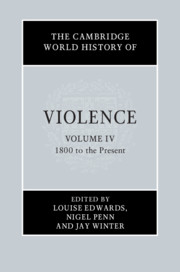Book contents
- The Cambridge World History of Violence
- The Cambridge History of Violence
- The Cambridge World History of Violence
- Copyright page
- Contents
- Figures and Maps
- Contributors to Volume IV
- Introduction to Volume IV
- Part I Race, Religion and Nationalism
- Part II Intimate and Gendered Violence
- Part III Warfare, Colonialism and Empire in the Modern World
- 11 Frontier Violence in the Nineteenth-Century British Empire
- 12 Genealogies of Modern Violence: Arendt and Imperialism in Africa, 1830–1914
- 13 Religious Dynamics and the Politics of Violence in the Late Ottoman and Post-Ottoman Levant
- 14 Violence and the First World War
- 15 Witnessing and Fighting Nazi Violence during World War II
- 16 Violence and the Japanese Empire
- Part IV The State, Revolution and Social Change
- Part V Representations and Constructions of Violence
- Index
- References
13 - Religious Dynamics and the Politics of Violence in the Late Ottoman and Post-Ottoman Levant
from Part III - Warfare, Colonialism and Empire in the Modern World
Published online by Cambridge University Press: 13 March 2020
- The Cambridge World History of Violence
- The Cambridge History of Violence
- The Cambridge World History of Violence
- Copyright page
- Contents
- Figures and Maps
- Contributors to Volume IV
- Introduction to Volume IV
- Part I Race, Religion and Nationalism
- Part II Intimate and Gendered Violence
- Part III Warfare, Colonialism and Empire in the Modern World
- 11 Frontier Violence in the Nineteenth-Century British Empire
- 12 Genealogies of Modern Violence: Arendt and Imperialism in Africa, 1830–1914
- 13 Religious Dynamics and the Politics of Violence in the Late Ottoman and Post-Ottoman Levant
- 14 Violence and the First World War
- 15 Witnessing and Fighting Nazi Violence during World War II
- 16 Violence and the Japanese Empire
- Part IV The State, Revolution and Social Change
- Part V Representations and Constructions of Violence
- Index
- References
Summary
This chapter explores patterns of violence, particularly domestic jihad, that emerged during the comprehensive crisis of the late Ottoman sultanate-caliphate and which have continued to this day after the latter’s end in the early 1920s. Rooted in ethno-religious inequality, conflicting eschatology and the experience of superior power in the West, these patterns of violence are often controlled by, or go in tandem with a type of partisan state characteristic of the late and post-Ottoman Middle East. Put generally, they are part of war in the name of religion, nation, and eschatology; target non-Sunnites; and encompass pogroms, show executions, coerced circumcisions, demographic engineering, and, more recently, serial suicide attacks and globally mediatised atrocities. The chapter understands the persistence of such violence in the post-Ottoman societies as an ongoing lack of effective supra-religious social contracts. Also, it scrutinizes the failure of attempts to achieve them and argues that negotiating them is nowhere more demanding than in a geography where the historical claims of all revealed monotheisms meet, and where religious or confessional mobilisation is crucial. Given the force of diverging eschatologies claiming supremacy for their groups and projecting the future in absolute terms, it is hard to see an end to polarisation in the present Levant.
- Type
- Chapter
- Information
- The Cambridge World History of Violence , pp. 263 - 285Publisher: Cambridge University PressPrint publication year: 2020

